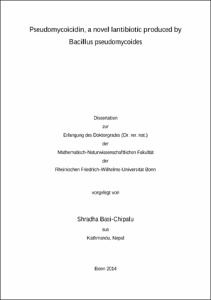Pseudomycoicidin, a novel lantibiotic produced by Bacillus pseudomycoides

Pseudomycoicidin, a novel lantibiotic produced by Bacillus pseudomycoides

| dc.contributor.advisor | Bierbaum, Gabriele | |
| dc.contributor.author | Basi-Chipalu, Shradha | |
| dc.date.accessioned | 2020-04-20T02:29:28Z | |
| dc.date.available | 2020-04-20T02:29:28Z | |
| dc.date.issued | 12.09.2014 | |
| dc.identifier.uri | https://hdl.handle.net/20.500.11811/6176 | |
| dc.description.abstract | The continuous increase of antibiotic resistant pathogens necessitates a search for new antibiotics. In this study a novel lantibiotic gene cluster was identified using the publicly available genome database. Blast searches employing the biosynthetic enzyme of the lantibiotic mersacidin (MrsM) in the NCBI database revealed a putative class II lantibiotic gene cluster in Bacillus pseudomycoides DSM 12442. Lantibiotics are lanthionine and methyllanthionine containing antimicrobial peptides. They are ribosomally synthesized antimicrobial peptides with extensive posttranslational modifications. During the posttranslational modification, lanthionine and methyllanthionine are introduced to the peptide by means of dehydration of Ser/Thr residues, followed by the reaction of the didehydro amino acids with cysteines to form the thioether linkages. The structural (lanA), modification (lanM, lanB, lanC, lanP, labKC and lanL), regulation (lanR, lanK), export (lanT (P)) and immunity genes (lanEFG) are organized in the biosynthetic gene clusters. The aim of the project was to characterize the putative lantibiotic gene cluster from B. pseudomycoides. In production assays, the cell wash extract of B. pseudomycoides showed the presence of an antimicrobial substance. The antimicrobial substance exhibited an activity against Gram-positive bacteria. The substance was partially purified by RP-HPLC, and the subsequent MALDI TOF MS predicted a mass of 2786.0 Da for an active peptide. The putative pseA and pseM genes from the predicted lantibiotic gene cluster of B. pseudomycoides were heterologously expressed in E. coli. The coexpression of the prepeptide (PseA) along with its corresponding modification enzyme (PseM) resulted in the production of a modified peptide, with four out of eight possible dehydrations. After the proteolytic removal of the leader peptide in vitro from the heterologously produced peptide, the core peptide showed an antimicrobial activity against the indicator strain M. luteus. The mass of the heterologously produced peptide was 2785.6 Da, which corresponded to the mass of the antimicrobial substance produced by B. pseudomycoides. This antimicrobial peptide is a novel class II lantibiotic and was named pseudomycoicidin. The chemical assays (IAA and βME) demonstrated the presence of four Lan/MeLan rings and one additional disulfide bond in the peptide. Further experiments are required to confirm the structure of the peptide and its mode of action. | en |
| dc.language.iso | eng | |
| dc.rights | In Copyright | |
| dc.rights.uri | http://rightsstatements.org/vocab/InC/1.0/ | |
| dc.subject.ddc | 570 Biowissenschaften, Biologie | |
| dc.subject.ddc | 610 Medizin, Gesundheit | |
| dc.title | Pseudomycoicidin, a novel lantibiotic produced by Bacillus pseudomycoides | |
| dc.type | Dissertation oder Habilitation | |
| dc.publisher.name | Universitäts- und Landesbibliothek Bonn | |
| dc.publisher.location | Bonn | |
| dc.rights.accessRights | openAccess | |
| dc.identifier.urn | https://nbn-resolving.org/urn:nbn:de:hbz:5n-37516 | |
| ulbbn.pubtype | Erstveröffentlichung | |
| ulbbnediss.affiliation.name | Rheinische Friedrich-Wilhelms-Universität Bonn | |
| ulbbnediss.affiliation.location | Bonn | |
| ulbbnediss.thesis.level | Dissertation | |
| ulbbnediss.dissID | 3751 | |
| ulbbnediss.date.accepted | 28.08.2014 | |
| ulbbnediss.institute | Medizinische Fakultät / Institute : Institut für Medizinische Mikrobiologie, Immunologie und Parasitologie (IMMIP) | |
| ulbbnediss.fakultaet | Mathematisch-Naturwissenschaftliche Fakultät | |
| dc.contributor.coReferee | Sahl, Hans-Georg |
Files in this item
This item appears in the following Collection(s)
-
E-Dissertationen (4163)




